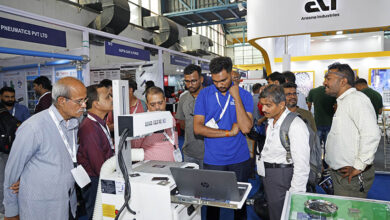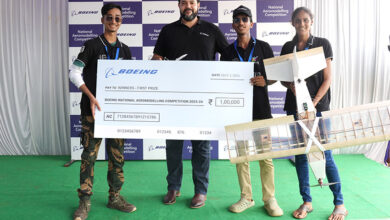By R. Anil Kumar
- India is undoubtedly on a trajectory to become a space superpower and influential player in the global space community. Still, it may take some time to be considered a “space superpower” on par with the United States of America (National Aeronautics and Space Administration NASA), the European Space Agency (ESA) and the Russia State Space Corporation (ROSCOMOS) established leaders
- The pace of India’s space developments is impressive, with almost a 99.9% success rate
- Indian Space Research Organisation (ISRO) has launched 431 satellites for 34 countries as of end July 2023
Bangalore, October 31. If the first 50 years of its journey, ISRO focussed on tapping space technology for societal benefits through satellite-based missions, with the Chandrayaan-3, ISRO has signalled strongly that in the coming decades, it’s going to emerge a formidable player in the satellite-launch market and inter-planetary missions.

The successful landing of Chandrayaan-3 on the moon on August 23 is a ‘big step’ for India’s space odyssey and could well be a ‘giant leap’ for the future of planetary and space sciences.
By safely guiding the Vikram lander onto the ‘dark’ side of the south pole of the lunar surface and releasing Pragyan, the rover, the Indian Space Research Organisation (ISRO) has broken into a totally new orbit — the exclusive club of the most advanced space nations, as it moves into its seventh decade of operations.
In the history-making flight, ISRO ensured that India cornered the glory of becoming the first nation to land closest to the south pole. It is the fourth country after the space giants to land on the moon, after the US, Russia and China.
Missions Ahead
In its sights are the mission to the Sun, Aditya L1; the probe to Venus; the second mission of the Mars orbiter mission (Mangalyaan-2); manned space mission (Gaganyaan); reusable launch vehicle (RLV); and a small satellite launch vehicle (SSLV).

It is also planning a host of global partnerships, with the US for the Artemis Project and the NISAR (NASA-ISRO Synthetic Aperture Radar); with France in meteorology, and Japan’s JAXA.
Now, the space agency, whose success mantra is “frugal innovation, cost effective and high performing technology capability, strong industry collaboration”, will focus on mega projects.
It will be ably complemented by Indian industry and start-ups, which have got a big boost with the government introducing reforms and incentives through a new Space Policy of 2021.
Today, ISRO, headquartered in Bengaluru and with institutes spread across the country, has a modest budget of approximately $1.6 billion (Rs.13,700 crore).
It’s important to note that while India’s space program operates on a lower budget than some other countries, it has achieved significant milestones and continues making valuable contributions to space science, satellite technology, and Earth, Mars, Moon and Sun monitoring.
This cost-effective approach has allowed ISRO to make space more
 accessible and affordable, benefiting India and the global space community.
accessible and affordable, benefiting India and the global space community.
It has highly motivated scientists, mostly drawn from national engineering colleges and a rising leadership role for women scientists. The infrastructure is growing with a second launch pad getting ready in Sriharikota for use by the private sector.
Challenging Ride
ISRO has launched 431 satellites for 34 countries as of end July 2023. The story began with the launch of Aryabhatta on April 19, 1975, with the help of the Soviet Union.
It has not always been an easy ride, though. Failures have been the stepping stones to success for the untiring and motivated ISRO scientists.
Right from Aryabhatta to SLV-3 and from GSLV to the latest Chandrayaan-3, the agency has faced many challenges. But every time, it has bounced back. The best combination being the success of Chandrayaan-3, which is powered by the heaviest GSLV MK3 launcher.
In the launch vehicle segment, the future belongs to reusable rockets. They will make launching very cost effective and give a competitive advantage.
ISRO has made promising progress in the last seven years in the development and launching its own RLV. All the existing ISRO vehicles are expendable and the changeover to RLV will be a game changer for it.

Navigational Satellites
ISRO, along with Airports Authority of India, jointly developed GAGAN (GPS Aided Geo Augmented Navigation) system for air traffic control.
It is a system of satellites and ground stations that provide GPS signal corrections, giving the best positional accuracy.
ISRO also developed Navigation with Indian Constellation (NavIC), an independent regional navigation satellite system to provide accurate position information service to users in India as well as the region extending up to 1,500 kms from its borders.
ISRO’s cost-effective approach can be attributed to several factors:

Frugal Engineering:
ISRO is known for its frugal engineering practices, which involve finding innovative and cost-efficient solutions for space missions.
This approach includes designing spacecraft with minimalistic yet practical features and using existing technologies whenever possible.
Skilled Workforce:
India has a skilled science, technology, and engineering workforce, which helps reduce labour costs while maintaining high-quality work.
Government Support:
The Indian government has supported ISRO’s initiatives, providing the necessary funding and resources for space missions.
Incremental Progress:
ISRO has taken an incremental approach to space exploration, gradually building on previous successes, which can help control costs.
Collaboration:
ISRO often collaborates with international partners, sharing resources and costs for specific missions.
Ancient Knowledge:
Often, people refer to a link between old Indian knowledge and new space science about a connection between ancient Indian knowledge and modern space science. There are some interesting parallels and contributions that can be drawn:
Astronomy and Mathematics:
Ancient Indian civilizations, particularly the Indus Valley Civilization and later Vedic texts, had advanced knowledge of astronomy and mathematics. The concepts of zero, decimal notation, and trigonometry were developed in India.
These mathematical advancements are fundamental to modern space science and technology, as they form the basis for calculations related to orbits, trajectories, and celestial mechanics.
Celestial Observations:
Ancient Indian astronomers made detailed observations of celestial bodies and their movements. Aryabhata, Brahmagupta, and Varahamihira are some notable Indian astronomers who made significant contributions.
These observations laid the foundation for understanding celestial phenomena and were used in early space exploration.
Vedic Cosmology:
The Vedas, ancient Indian texts, contain cosmological ideas that describe the universe in ways that have some parallels to modern cosmology.
These ancient texts inspired later astronomers and thinkers to explore the nature of the universe, which eventually contributed to the development of modern space science.
Calendar Systems:
Ancient Indian civilizations developed intricate calendar systems based on lunar and solar cycles. These calendars were used to predict celestial events and agricultural activities. In modern space science, precise calendar systems are still essential for planning missions and predicting astronomical events.
Yoga and Mind-Body Connection:
While not directly related to space science, traditional practices like yoga and meditation have gained attention from astronauts and scientists for their potential benefits in addressing the psychological challenges of space travel, such as isolation and stress.
It’s important to emphasize that the connections between ancient Indian knowledge and modern space science are more in inspiration, historical context, and some foundational concepts rather than direct contributions to space technology or contemporary scientific understanding. Nevertheless, the rich history of Indian knowledge has left an indelible mark on the broader fields of science and mathematics, which have played significant roles in space science and technology development.
With such a strong foundation, motivated staff, impressive achievements, increasing private sector participation and support from the government, ISRO can be a global superpower to reckon with in space technology.





